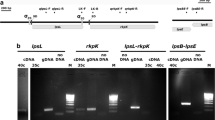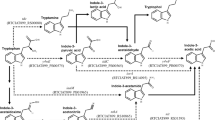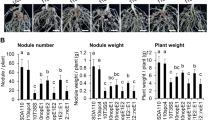Abstract
The Sinorhizobium fredii HH103 rkp-1 region, which is involved in capsular polysaccharide (KPS) biosynthesis, is constituted by the rkpU, rkpAGHIJ, and kpsF3 genes. Two mutants in this region affecting the rkpA (SVQ536) and rkpI (SVQ538) genes were constructed. Polyacrylamide gel electrophoresis and 1H-NMR analyses did not detect KPS in these mutants. RT-PCR experiments indicated that, most probably, the rkpAGHI genes are cotranscribed. Glycine max cultivars (cvs.) Williams and Peking inoculated with mutants SVQ536 and SVQ538 showed reduced nodulation and symptoms of nitrogen starvation. Many pseudonodules were also formed on the American cv. Williams but not on the Asiatic cv. Peking, suggesting that in the determinate nodule-forming S. fredii-soybean symbiosis, bacterial KPS might be involved in determining cultivar-strain specificity. S. fredii HH103 mutants unable to produce KPS or exopolysaccharide (EPS) also showed reduced symbiotic capacity with Glycyrrhiza uralensis, an indeterminate nodule-forming legume. A HH103 exoA-rkpH double mutant unable to produce KPS and EPS was still able to form some nitrogen-fixing nodules on G. uralensis. Thus, here we describe for the first time a Sinorhizobium mutant strain, which produces neither KPS nor EPS is able to induce the formation of functional nodules in an indeterminate nodule-forming legume.





Similar content being viewed by others
References
Becker A, Pühler A (1998) Production of exopolysaccharides. In: Spaink HP, Kondorosi A, Hooykaas PJJ (eds) The Rhizobiaceae: molecular biology of model plant-associated bacteria. Kluwer, Dordrecht, pp 97–118
Becker A, Schimdt M, Jäger W, Pühler A (1995) New gentamicin-resistance and lacZ promote-probe cassettes suitable for insertion mutagenesis and generation of transcriptional fusions. Gene 162:37–39
Becker A, Fraysse N, Sharypova L (2005) Recent advances in studies on structure and symbiosis-related function of rhizobial K-antigens and lipopolysaccharides. Mol Plant Microbe Interact 18:899–905
Beringer JE (1974) R factor transfer in Rhizobium leguminosarum. J Gen Microbiol 84:188–198
Bliss J, Garon C, Silver R (1996) Polysialic acid export in Escherichia coli K1: the role of KpsT, the ATP-binding component of an ABC transporter, in chain translocation. Glycobiology 6:445–452
Buendía-Clavería AM, Chamber M, Ruiz-Sainz JE (1989) A comparative study of the physiological characteristics, plasmid content and symbiotic properties of different Rhizobium fredii strains. Syst Appl Microbiol 12:203–209
Buendía-Clavería AM, Moussaid A, Ollero FJ, Vinardell JM, Torres A, Moreno J, Gil-Serrano AM, Rodríguez-Carvajal MA, Tejero-Mateo P, Peart JL, Brewin NJ, Ruiz-Sainz JE (2003) A purL mutant of Sinorhizobium fredii HH103 is symbiotically defective and altered in its lipopolysaccharide. Microbiology 149:1807–1818
Chataigné G, Conderc F, Poinsot V (2008) Polysaccharides analysis of sinorhizobial capside by on-line anion exchange chromatography with pulse amperiometric detection and mass spectrometry coupling. J Chromatogr A 1185:241–250
Collmer A, Bauer DW, He SY, Lindeberg M, Kelemu S, Rodriguez-Palenzuela P, Burr TJ, Chatterjee AK (1991) Pectic enzyme production and bacterial plant pathogenicity. In: Hennecke H, Verma DPS (eds) Advances in molecular genetics of plant-microbe interactions, vol 1. Kluwer, Dordrecht, pp 65–72
Crespo-Rivas JC, Margaret I, Pérez-Montaño F, López-Baena FJ, Vinardell JM, Ollero FJ, Moreno J, Ruiz-Sainz JE, Buendía-Clavería AM (2007) A pyrF auxotrophic mutant of Sinorhizobium fredii HH103 is impaired in its symbiotic interactions with soybean and other legumes. Int Microbiol 10:169–176
Crespo-Rivas JC, Margaret I, Hidalgo A, Buendía-Clavería AM, Ollero FJ, López-Baena FJ, Murdoch PS, Rodríguez-Carvajal MA, Soria-Díaz ME, Reguera M, Lloret J, Sumpton DP, Mosely JA, Thomas-Oates JE, van Brussel AAN, Gil-Serrano A, Vinardell JM, Ruiz-Sainz JE (2009) Sinorhizobium fredii HH103 cgs mutants are unable to nodulate determinate- and indeterminate nodule-forming legumes and overproduce an altered EPS. Mol Plant Microbe Interact 22:575–588
De Lyra MCCP, López-Baena FJ, Madinabeitia N, Vinardell JM, Espuny MR, Cubo MT, Bellogín RA, Ruiz-Sainz JE, Ollero FJ (2006) Inactivation of the Sinorhizobium fredii HH103 rhcJ gene abolishes nodulation outer proteins (Nops) secretion and decreases the symbiotic capacity with soybean. Int Microbiol 9:125–133
Downie JA (2010) The roles of extracellular proteins, polysaccharides and signals in the interactions of rhizobia with legume roots. FEMS Microbiol Rev 34:150–170
Figurski DH, Helinski DR (1979) Replication of an origin-containing derivative of plasmid RK2 dependent on a plasmid function provided in trans. Proc Natl Acad Sci USA 76:1648–1652
Fraysse N, Couderc C, Poinsot V (2003) Surface polysaccharides involvement in establishing the Rhizobium-legume symbiosis. Eur J Biochem 270:1365–1380
Fraysse N, Lindner B, Kaczynski Z, Sharypova L, Holst O, Niehaus K, Poisont V (2005) Sinorhizobium meliloti strain 1021 produces a low-molecular mass capsular polysaccharide that is a homopolymer of 3-deoxy-d-manno-oct-2-ulosonic acid harbouring a phospholipidic anchor. Glycobiology 15:101–108
Friedman AM, Long SR, Brown SE, Buikema WJ, Ausubel FM (1982) Construction of a broad host range cosmid cloning vector and its use in the genetic analysis of Rhizobium mutants. Gene 18:289–296
Gage DJ (2004) Infection and invasion of roots by symbiotic, nitrogen-fixing rhizobia during nodulation of temperate legumes. Mol Biol Rev 68:280–300
Gibson KE, Kobayasi H, Walker GC (2008) Molecular determinants of a symbiotic chronic infection. Ann Rev Genet 42:413–441
Gil-Serrano AM, Rodríguez-Carvajal MA, Tejero-Mateo P, Espartero JL, Menendez M, Corzo J, Ruiz-Sainz JE, Buendía-Clavería AM (1999) Structural determination of a 5-acetamido-3,5,7,9-tetradeoxy-7-(3-hydroxybutyramido)-l-glycero-l-manno-nonusolonic acid-containing homopolysaccharide isolated from Sinorhizobium fredii HH103. Biochem J 342:527–535
Hidalgo A, Margaret I, Crespo-Rivas JC, Parada M, Murdoch PS, Lopez A, Buendia-Claveria AM, Moreno J, Albareda M, Gil-Serrano AM, Rodriguez-Carvajal MA, Palacios JM, Ruiz-Sainz JE, Vinardell JM (2010) The rkpU gene of Sinorhizobium fredii HH103 is required for bacterial KPS production and for efficient nodulation with soybean but not with Vigna unguiculata. Microbiology 156:3398–3411
Jones KM, Kobayashi H, Davies BW, Taga ME, Walker G (2007) How rhizobial symbionts invade plants: the Sinorhizobium-Medicago model. Nature 5:619–633
Kannenberg EL, Reuhs BL, Fosberg LS, Carlson RW (1998) Lipopolysaccharide and K-antigens: their structures, biosynthesis and functions. In: Spaink HP, Kondorosi A, Hooykaas PJJ (eds) The Rhizobiaceae: molecular biology of model plant-associated bacteria. Kluwer, Dordrecht, pp 119–154
Kinkema M, Scott PT, Gresshoff PM (2006) Legume nodulation: successful symbiosis through short- and long-distance signalling. Funct Plant Biol 33:707–721
Kiss E, Reuhs BL, Kim JS, Kereszt A, Petrovics G, Putnoky P, Dusha I, Carlson RW, Kondorosi A (1997) The rkpGHI and −J genes are involved in capsular polysaccharide production by Rhizobium meliloti. J Bacteriol 179:2132–2140
Kiss E, Kereszt A, Barta F, Stephens B, Reuhs BL, Kondorosi A, Putnoky P (2001) The rkp-3 region of Sinorhizobium meliloti Rm41 contains strain-specific genes that determine K antigen structure. Mol Plant Microbe Interact 14:1395–1403
Lamrabet Y, Bellogín RA, Cubo T, Espuny MR, Gil-Serrano A, Krishnan HB, Megías M, Ollero FJ, Pueppke SG, Ruiz-Sainz JE, Spaink HP, Tejero-Mateo P, Thomas-Oates J, Vinardell JM (1999) Mutation in GDP-fucose synthesis genes of Sinorhizobium fredii alters Nod factors and significantly decreases competitiveness to nodulate soybeans. Mol Plant Microbe Interact 12:207–217
Madinabeitia N, Bellogín RA, Buendía-Clavería A, Camacho M, Cubo T, Espuny MR, Gil-Serrano AM, Lyra MCCP, Moussaid A, Ollero FJ, Soria-Díaz ME, Vinardell JM, Zeng J, Ruiz-Sainz JE (2002) Sinorhizobium fredii HH103 has a truncated nolO gene due to a −1 frameshift mutation that is conserved among other geographically distant S. fredii strains. Mol Plant Microbe Interact 15:150–159
Meinhardt LW, Krishnan HB, Balatti PA, Pueppke SG (1993) Molecular cloning and characterization of a sym plasmid locus that regulates cultivar-specific nodulation of soybean by Rhizobium fredii USDA257. Mol Microbiol 9:17–29
Müller MG, Forsberg LS, Keating DH (2009) The rkp-1 cluster is required for secretion of Kdo homopolymeric capsular polysaccharide in Sinorhizobium meliloti strain Rm1021. J Bacteriol 191:6988–7000
Parada M, Vinardell JM, Ollero FJ, Hidalgo A, Gutiérrez R, Buendía-Clavería AM, Lei W, Margaret I, López-Baena FJ, Gil-Serrano AM, Rodríguez-Carvajal MA, Moreno J, Ruiz-Sainz JE (2006) Sinorhizobium fredii HH103 mutants affected in capsular polysaccharide (KPS) are impaired for nodulation with soybean and Cajanus cajans. Mol Plant Microbe Interact 19:43–52
Pellock BJ, Cheng HP, Walker GC (2000) Alfalfa root nodule invasion efficiency is dependent on Sinorhizobium meliloti polysaccharides. J Bacteriol 182:4310–4318
Petrovics G, Putnoky P, Reuhs B, Kim J, Thorp TA, Noel KD, Carlson RW, Kondorosi A (1993) The presence of a novel type of surface polysaccharide in Rhizobium meliloti requires a new fatty acid synthase-like genes cluster involved in symbiotic nodule development. Mol Microbiol 8:1083–1094
Prentki P, Krisch HM (1984) In vitro insertional mutagenesis with a selectable DNA fragment. Gene 29:303–313
Reuhs BL, Stephens SB, Kim JS, Glenn J, Pzrytycki J, Ojanen-Reuhs T (1999) Epitope identification for a panel of anti-Rhizobium meliloti monoclonal antibodies and application to the analysis of K antigens and lipopolysaccharides from bacteroids. Appl Environ Microbiol 65:5186–5191
Rodríguez-Carvajal MA, Tejero-Mateo P, Espartero JL, Ruiz-Sainz JE, Buendía-Clavería AM, Ollero FJ, Yang SS, Gil-Serrano AM (2001) Determination of the chemical structure of the capsular polysaccharide of strain B33, a fast-growing soya bean-nodulating bacterium isolated from an arid region of China. Biochem J 357:505–511
Sambrook J, Fritsch EF, Maniatis T (1989) Molecular cloning. A laboratory manual. Cold Spring Harbor Laboratory Press, Cold Spring Harbor, NY
Schafer A, Tauch A, Jager W, Kalinowski J, Thierbach G, Pühler A (1994) Small mobilizable multi-purpose cloning vectors derived from the Escherichia coli plasmids pK18 and pK19: selection of defined deletions in the chromosome of Corynebacterium glutamicum. Gene 145:69–73
Simon R (1984) High frequency mobilization of gram-negative bacterial replicons by the in vivo constructed Tn5-Mob transposon. Mol Gen Genet 196:413–420
Simsek S, Ojanen-Reuhs T, Marie C, Reuhs B (2009) An apigenin-induced decrease in K-antigen production by Sinorhizobium sp. NGR234 is y4gM and nodD1-dependent. Carbohydr Res 344:1947–1950
Thomas-Oates J, Bereszczak J, Edwards E, Gill A, Noreen S, Zhou JC, Chen MZ, Miao LH, Xie FL, Yang JK, Zhou Q, Yang SS, Li XH, Wang L, Spaink HP, Schlaman HRM, Harteveld M, Díaz CL, van Brussel AAN, Camacho M, Rodríguez-Navarro DN, Santamaría C, Temprano F, Acebes JM, Bellogín RA, Buendía-Clavería AM, Cubo MT, Espuny MR, Gil AM, Gutiérrez R, Hidalgo A, López-Baena FJ, Madinabeitia N, Medina C, Ollero FJ, Vinardell JM, Ruiz-Sainz JE (2003) A catalogue of molecular, physiological and symbiotic properties of soybean-nodulating rhizobial strains from different soybean cropping areas of China. Syst Appl Microbiol 26:453–465
Vanderlinde EM, Harrison JJ, Muszynski A, Carlson RW, Turner RJ, Yost CK (2010) Identification of a novel ABC transporter required for desiccation tolerance, and biofilm formation in Rhizobium leguminosarum bv. viciae 3841. FEMS Microbiol Ecol 71:327–340
Vinardell JM, López-Baena FJ, Hidalgo A, Ollero FJ, Bellogín R, Espuny MR, Temprano F, Romero F, Krishnan HB, Pueppke SG, Ruiz-Sainz JE (2004a) The effect of FITA mutations on the symbiotic properties of Sinorhizobium fredii varies in a chromosomal-background-dependent manner. Arch Microbiol 181:144–154
Vinardell JM, Ollero FJ, Hidalgo A, López-Baena FJ, Medina C, Ivanov-Vangelov K, Parada M, Madinabeitia N, Espuny MR, Bellogín RA, Camacho M, Rodríguez-Navarro DN, Soria-Díaz ME, Gil-Serrano AM, Ruiz-Sainz JE (2004b) NolR regulates diverse symbiotic signals of Sinorhizobium fredii HH103. Mol Plant Microbe Interact 17:676–685
Vincent JM (1970) Appendix III. The modified Fähraeus slide technique. In: Vincent JM (ed) A manual for the practical study of root nodule bacteria. Blackwell Scientific Publications, Oxford, pp 144–145
Wallis JG, Watts JL, Browse J (2002) Polyunsaturated fatty acid synthesis: what will they think of next? Trends Biochem Sci 27:467–473
Yang S, Bellogín RA, Buendía-Clavería AM, Camacho M, Chen M, Cubo T, Daza A, Díaz CL, Espuny MR, Gutiérrez R, Harteveld M, Li XH, Lyra MCCP, Madinabeitia N, Medina C, Miao L, Ollero FJ, Olsthoorn MMA, Rodríguez DN, Santamaría C, Schlaman HRM, Spaink HP, Temprano F, Thomas-Oates JE, van Brussel AAN, Vinardell JM, Xie F, Yang J, Zhang HY, Zhen J, Zhou J, Ruiz-Sainz JE (2001) Effect of pH and soybean cultivars on the quantitative analyses of soybean rhizobia populations. J Biotechnol 91:243–255
Acknowledgments
We thank Abigail López for technical assistance and Piedad del Socorro Murdoch and Anton van Brussel for critical reading of the manuscript. This work was supported by grants BIO2008-05736-C02-02 of the Spanish Ministry of Science and Innovation and P07-CVI-02506 of the Andalusia Government.
Author information
Authors and Affiliations
Corresponding author
Additional information
Communicated by Ursula Priefer.
Rights and permissions
About this article
Cite this article
Margaret-Oliver, I., Lei, W., Parada, M. et al. Sinorhizobium fredii HH103 does not strictly require KPS and/or EPS to nodulate Glycyrrhiza uralensis, an indeterminate nodule-forming legume. Arch Microbiol 194, 87–102 (2012). https://doi.org/10.1007/s00203-011-0729-2
Received:
Revised:
Accepted:
Published:
Issue Date:
DOI: https://doi.org/10.1007/s00203-011-0729-2




